人教版英语必修四Unit1Women of achieve教案
- 格式:doc
- 大小:66.00 KB
- 文档页数:4
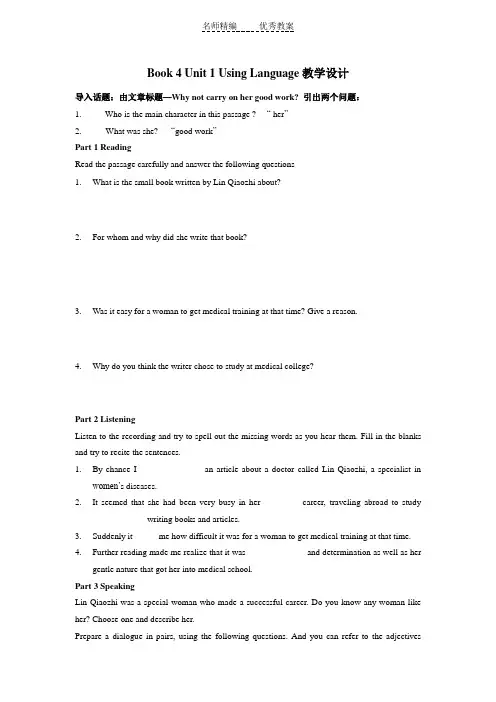
Book 4 Unit 1 Using Language教学设计导入话题:由文章标题—Why not carry on her good work? 引出两个问题:1.Who is the main character in this passage ? ---“ her”2.What was she? --- “good work”Part 1 ReadingRead the passage carefully and answer the following questions1.What is the small book written by Lin Qiaozhi about?_______________________________________________________________________________ ________2.For whom and why did she write that book?_______________________________________________________________________________ _______________________________________________________________________________ ________________3.Was it easy for a woman to get medical training at that time? Give a reason._______________________________________________________________________________ ________4.Why do you think the writer chose to study at medical college?_______________________________________________________________________________ _______Part 2 ListeningListen to the recording and try to spell out the missing words as you hear them. Fill in the blanks and try to recite the sentences.1.By chance I ______________ an article about a doctor called Lin Qiaozhi, a specialist inwomen’s diseases.2.It seemed that she had been very busy in her ________ career, traveling abroad to study____________ writing books and articles.3.Suddenly it _____ me how difficult it was for a woman to get medical training at that time.4.Further reading made me realize that it was _____________ and determination as well as hergentle nature that got her into medical school.Part 3 SpeakingLin Qiaozhi was a special woman who made a successful career. Do you know any woman like her? Choose one and describe her.Prepare a dialogue in pairs, using the following questions. And you can refer to the adjectivesPart 4 WritingWrite a short description of the woman you have talked about with your deskmate, following the_______________________________________________________________________________ _______________________________________________________________________________ _______________________________________________________________________________ _______________________________________________________________________________ _______________________________________________________________________________ _______________________________________________________________________________ _______________________________________________________________________________ ______________________________________________________________________________________________________________________________________ _______________________________________________________________________________ ________________【Self-reflection】What have I learned from this class?How can I put what I have learned into practice?。
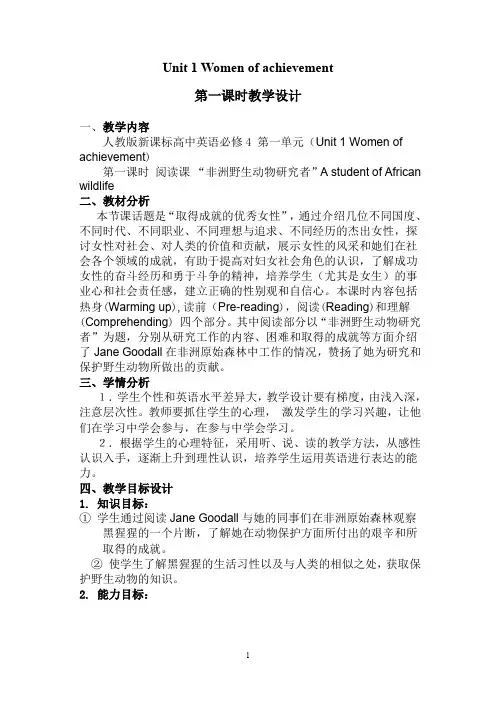
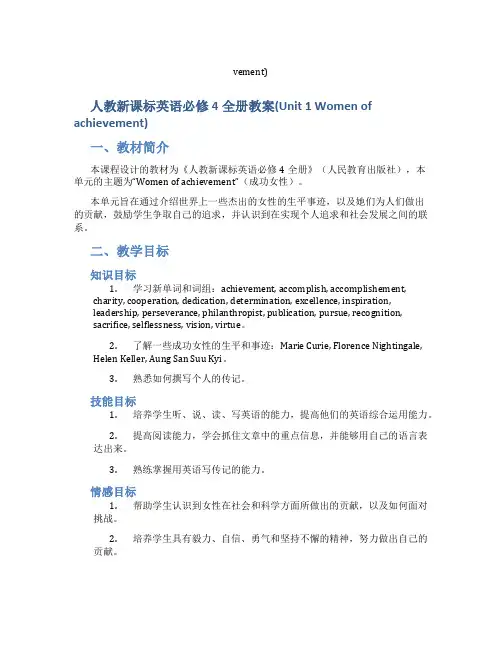
vement)人教新课标英语必修4全册教案(Unit 1 Women of achievement)一、教材简介本课程设计的教材为《人教新课标英语必修4全册》(人民教育出版社),本单元的主题为“Women of achievement”(成功女性)。
本单元旨在通过介绍世界上一些杰出的女性的生平事迹,以及她们为人们做出的贡献,鼓励学生争取自己的追求,并认识到在实现个人追求和社会发展之间的联系。
二、教学目标知识目标1.学习新单词和词组:achievement, accomplish, accomplishement,charity, cooperation, dedication, determination, excellence, inspiration,leadership, perseverance, philanthropist, publication, pursue, recognition,sacrifice, selflessness, vision, virtue。
2.了解一些成功女性的生平和事迹:Marie Curie, Florence Nightingale,Helen Keller, Aung San Suu Kyi。
3.熟悉如何撰写个人的传记。
技能目标1.培养学生听、说、读、写英语的能力,提高他们的英语综合运用能力。
2.提高阅读能力,学会抓住文章中的重点信息,并能够用自己的语言表达出来。
3.熟练掌握用英语写传记的能力。
情感目标1.帮助学生认识到女性在社会和科学方面所做出的贡献,以及如何面对挑战。
2.培养学生具有毅力、自信、勇气和坚持不懈的精神,努力做出自己的贡献。
三、教学过程1. Lead-in让学生看一下单元标题“Women of achievement”,并让学生回答以下问题:•你对这个词有什么印象?•你认为哪些女性是成功的?通过这种方式,引导学生进入本单元的主题。
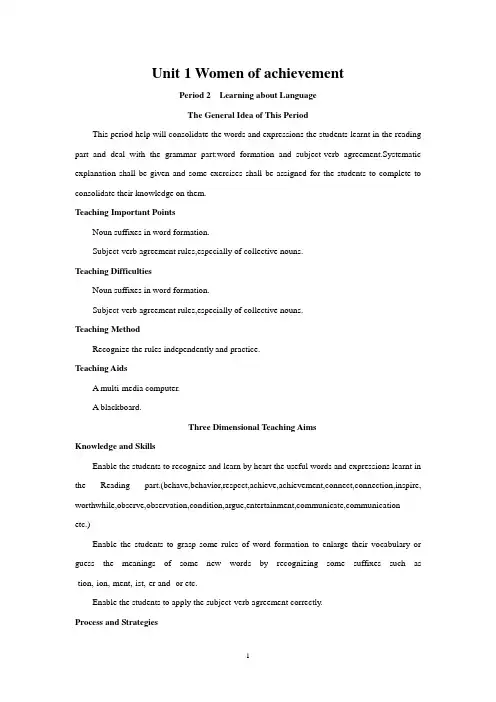
Unit 1 Women of achievementPeriod 2Learning about LanguageThe General Idea of This PeriodThis period help will consolidate the words and expressions the students learnt in the reading part and deal with the grammar part:word formation and subject-verb agreement.Systematic explanation shall be given and some exercises shall be assigned for the students to complete to consolidate their knowledge on them.Teaching Important PointsNoun suffixes in word formation.Subject-verb agreement rules,especially of collective nouns.Teaching DifficultiesNoun suffixes in word formation.Subject-verb agreement rules,especially of collective nouns.Teaching MethodRecognize the rules independently and practice.Teaching AidsA multi-media computer.A blackboard.Three Dimensional Teaching AimsKnowledge and SkillsEnable the students to recognize and learn by heart the useful words and expressions learnt in the Reading part.(behave,behavior,respect,achieve,achievement,connect,connection,inspire, worthwhile,observe,observation,condition,argue,entertainment,communicate,communication etc.)Enable the students to grasp some rules of word formation to enlarge their vocabulary or guess the meanings of some new words by recognizing some suffixes such as -tion,-ion,-ment,-ist,-er and -or etc.Enable the students to apply the subject-verb agreement correctly.Process and StrategiesSystematic explanation to make the students know how to apply the subject-verb agreementcorrectly.Feelings and ValueThrough the study of this period the students are sure to have a better understanding of thesubject-verb agreement.Teaching ProceduresStep 1 Revision1.Revise the content of the reading passage by asking the students some questions.T:Good morning,boys and girls!Last class we talked about some great women in theworld,remember?Ss:Yes.T:If I want to become a great woman,what is most important?Ss:You should be unselfish and willing to sacrifice and make contributions to the society.T:Good.Yesterday we talked about one of the great women and her life.Who is the greatwoman?Ss:Jane Goodall.T:What did she do?S:She protected the wildlife in Africa.S:She studied chimps and helped people understand chimp behavior and respect the lives of chimps.T:Right.Did she have to spend a lot of time achieving her goal?Ss:Yes.She has been doing that for forty years.T:With hard work,what did she discovered?S:She discovered that chimps hunt and eat meat.S:She discovered how chimps communicate with each other.S:She worked out their social system with the help of their body language.T:Wonderful job.Do you admire her?Ss:Of course.We will all follow her example and make ourselves useful persons.2.Check the assigned homework.T:Yesterday,you were expected to complete the exercises independently in Discovering usefulwords and expressions.Have you finished?Ss:Yes.T:Good.Now let’s check the answers.Please turn to Page 4.Let’s have a look at exercise 2 first. Now let’s check the answers.(Ask some students to the blackboard to write down their answers,then ask the other students to correct.)In the same way,check exercises 3 and 4.Step 2 Noun suffixes in word formation1.Brainstorm word formationT:We know that Jane Goodall has done a lot for the chimps.She has argued for the chimps to beleft in the wild.That is to say,what has she made for the chimps to be left in the wild?Ss:Arguments.She has made arguments for the chimps to be left in the wild.T:(writes argue and argument on the blackboard and underlines -ment) Good.She did a lot andfinally achieved her goal.That is to say,she made...?Ss:She made achievements.T:(writes achieve and achievement on the black board and underlines -ment) Good.Now l et’s have a look at the blackboard.Can you see anything in common in the two pairs ofwords?S:Yes.The noun “argument” comes from the verb “argue”,adding “-ment”.The noun “achievement” comes from the verb “achieve”,adding “-ment” too.We can see “-ment” ca n beadded to a verb to make a noun.T:Very good.You have very keen eyes.This way to form a new word is called word formation.Here,“-ment” is called a suffix,which can be added to another word to form a newword.Do you want to know more about suffixes?Ss:Yes.T:OK.Today we will talk about suffixes which can make another word into a noun.We call them noun suffixes.2.Introducing more noun suffixes.T:Now please have a look at the screen.Here are some groups of verbs.Say their meanings,please.(Ss say the meanings of the verbs.)organize determinediscuss examinedecide educatedirectT:Good.What about their nouns?Can you tell me?Ss:(say the nouns)organization determinationdiscussiondirection educationdecisionT:What is in common among these words?Ss:Suffix “-ion”,“-tion”,“-sion” or “-ation” is added to the verb to make a noun.T:Very good.So we can see “-i on”,“-tion”,“-sion” and “-ation” are some of the noun suffixes.Doyou know more suffixes?Can you give me some examples?S:Let me have a try.If I feel bad,that is to say,I have a feeling which is bad.If the word means right,that is to say the word have the meaning which is right.So we can see,“-ing” is also a noun suffix.T:(writes “feel”,“feeling”,“mean” and“meaning” on the blackboard and underlines “-ing”)Terrific job.Are there any other nouns with “ -ing”?Ss:Warning,finding etc.T:Who else will say something about other suffixes?S:You teach us English.That is to say,you are our English teacher.“-er” is a noun suffix.T:Good.Any more examples with “-er”?Ss:Writer,organizer etc.T:(writes down “-er” on the blackboard) What about other noun suffixe s?S:Thomas Edison invented the way of giving electricity.He was an inventor.“-or” is a noun suffix for a person.Another example is “sailor”from “sail”.T:(writes down “-or” on the blackboard) Right.S:I remember one more suffix for a person.For example,Yang Zhenning has made great contributions to the field of science.He is a scientist.“-ist” is a suffix for a person.T:(writes down “ ist” on the blackboard) Good job.In fact we have one more suffix for aperson.For example,if I interview you,you are my interviewee.“-ee”means a person too.( writes down “-ee” on the blackboard)3.Practice1)Check exercise 1 on Page 4.Show the table on the screen and get the students to say the answers aloud in chorus so that everyone will be aware of the suffixes.If they have any questions,give further explanation.2)Show some more words on the screen and get the students to guess their meanings according to the rules of word formation.They should be able to tell their meanings at the first sight.Instruct them to find out the root first and then guess the meanings of the words,taking the suffixes into consideration.pianist,typist,physicist,educationalistprotection,imagination,separation,educationpunishment,management,statement,requirement,entertainment,paymentprisoner,adviser,lecturer,climber4.SummaryT:Now we can see it is not really difficult to remember words as long as we master some rules.With the knowledge of word formation,we can enlarge our vocabulary.Today,we focus our attention on the Noun Suffix.In fact there are much more suffixes in English,later we will come across some of them.Step 3 Discovering useful structures (Subject-verb agreement)1.Brainstorm Subject-verb agreement by giving simple examples.T:Now watch me.What am I doing?(draws a picture on the blackboard)Ss:You are drawing on the blackboard.T:Yes.The teacher is drawing on the blackboard.(Writes the sentence “The teacher is drawing on the blackboard”.) What about you?What are you doing?Ss:We are watching and listening to you.T:(Writes the sentence “We are watching and listening to you.”)The teacher is drawing on the blackboard.We are watching and listening to you.Now please have a look at these two sentences.Can we say the teacher are drawing or we iswatching and listening to the teacher?Ss:No.T:Why?Ss:There are some rules for us to follow when we write sentences.T:You are right.When we write a sentence the predicate should agree with the subject,which is called subject-verb agreement.If we can not apply the rules correctly,we might not get ourselves understood.2.Instruct the students to discover the rules for subject-verb agreement.T:There are three main principles for us to follow.语法一致就近一致意义一致Show the students some sentences and get them to complete the sentences by filling in the predicate.Get them to observe the sentences and sum up the rules.T:Now please look at the screen and complete the sentences by filling in the blanks.A boy _________ sitting there.(be)Water _________ important to us.(be)S:Both the two blanks should be filled in “is”.T:Is he right?Ss:Yes.T:Now observe the sentences.Can you sum up one rule according to the two sentences?S:Let me have a try.When the subject is a noun in single form or is an abstract noun,the predicateshould be in single form.T:Very good.After being introduced to the rules,the students are asked to finish exercise 1 on Page 5.Here are the exercises with keys.1.The family is (be) very big.The family are (be) early risers.2.This class has (have) eighteen girls and twenty-five boys.This class are (be) very bright,especially in science subjects.3.The government is (be) made up of six high officials.The government were (be) having an important meeting when I got there.4.It was late,but the audience was (be) still entering the hall.The audience were (be) dressed in different ways.When the students are doing the exercises,the teacher leads them to pay more attention to thesecond and third groups of rules.3.Consolidation1) Get the students to do exercises 2 on Page 5.Dear Xiaoyu,I think everyone is (is/are) settled in London,although neither the weather nor the food is(is/are) good.Either rain or snow fell every day this week but everybody has (has/ have) tried to ignore it.My friends and my mother have(has/have) visited the theatre almost every night.None of them carries(carry/carries) an umbrella but nobody has(has/have) let that affect their activities.We are enjoying ourselves so much that I wonder if anybody wants(want/wants)to come home.This group of tourists love (love/loves) the culture and is (is/are) happy in England and would like tovisit London every summer!See you soon,Dong Xianshun 2)Divide the students into four groups and have a competition.The group that gets the most points will be the winners.1.The whole family _________ (be)watching TV.(are)2.Five minutes _________ (be) enough to do this exercise.( is)3.The news _________ (be)exciting.(was/is)4.The number of errors _________ (be)surprising.(was/ is)5.The crowd _________ (be)running for their lives.(are)6.Either your students or Mr.Wang _________ (know) this.(knows)7.The police _________ the murderer everywhere when he suddenly appeared in a theatre.(B)A.is searching forB.were searching forC.are searching forD.were searching8.The teacher,with 6 girls and 8 boys of her class, _________ visiting a museum when the earthquake struck.(A)A.wasB.wereC.had beenD.would beStep 4 Homework1.Page 43 Ex 1 Choose the best answers for the blanks.2.Page 44 Ex 2 Choose the right words and complete the short texts.3.Surf the Internet to find as much information as possible about Lin Qiaozhi.T:That’s all for this class,after class I hope you’ll prepare for the Speaking and Writing part,and finish the exercises on your exercise books.。
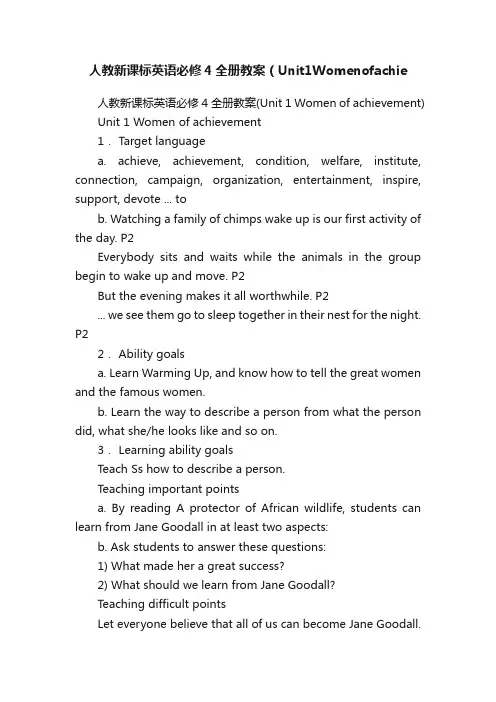
人教新课标英语必修4全册教案(Unit1Womenofachie人教新课标英语必修4全册教案(Unit 1 Women of achievement) Unit 1 Women of achievement1. Target languagea. achieve, achievement, condition, welfare, institute, connection, campaign, organization, entertainment, inspire, support, devote ... tob. Watching a family of chimps wake up is our first activity of the day. P2Everybody sits and waits while the animals in the group begin to wake up and move. P2But the evening makes it all worthwhile. P2... we see them go to sleep together in their nest for the night. P22. Ability goalsa. Learn Warming Up, and know how to tell the great women and the famous women.b. Learn the way to describe a person from what the person did, what she/he looks like and so on.3. Learning ability goalsTeach Ss how to describe a person.Teaching important pointsa. By reading A protector of African wildlife, students can learn from Jane Goodall in at least two aspects:b. Ask students to answer these questions:1) What made her a great success?2) What should we learn from Jane Goodall?Teaching difficult pointsLet everyone believe that all of us can become Jane Goodall.Teaching methodsInspiration, Questioning and Discussion.Teaching aidsA computer, a projector and a recorder.The first period readingProceduresStep I. Warming upWarming up by describingGood morning, class. Today we are going to read about A PROTECTOR OF AFRICAN WILDLIFE. But first, I’d like to know if you have ever heard of women like Elizabeth Fry, Soong Chingling, Jane Goodall, Jody Williams, Joan of Arc and Lin Qiaozhi. Now turn to page 1, look at the photos, read the captions and describe to your neighbor the women in focus. Who is she? What is she? What did she do to benefit the world?Warming up by discussingHi, every one. How did you spend your winter vacation? Did you read any books? Did you read any women of achievement? What makes a woman of achievement? Now in pairs discuss the women on page one. Which of these women do you think is a great woman? Give reasons for your choice.Warming up by reading aloud and translatingNice to see you back at school, boys and girls. As you have all prepared lessons before class I shall ask six of you at random to read aloud and translate the captions under the photos on page one. Zhao Yanfei, would you try reading aloud and translating the first caption?Well done! Next let’s have Ju Xiaohong do the second one.Step II. Pre-reading1. Looking and sayingWork in pairs. Look at the photos and the title A PROTECTOR OF AFRICAN WILDLIFE and predict the contents of the text. When you are ready, join another pair and compare your predictions and the clues that helped you to make the predictions.(Key: From the photos and title I guess that the text tells about a woman scientist who is working in Africa to protect the wildlife there. She studies a family of chimps, delivers a speech on their behaviour, arguing for them to be left in the wild and protected. )2. Talking and sharingWork in groups of four. Tell your group mates what you know about wildlife protection. Then the group leader is to stand up and share your group idea with the class.(Key: I am from Group 3. We think that Jane is a woman of achievement. For she has helped people understand how much chimps behave like humans. Because of her we know that it is better for the animals to be left in the wild or in the special places set up for them. )Step III. Reading1. Reading aloud to the recordingNow please listen and read aloud to the recording of the text A PROTECTOR OF AFRICAN WILDLIFE. Pay attention to the pronunciation of each word and the pauses within each sentence.I will play the tape twice and you shall read aloud twice, too.2. Reading and underliningNext you are to read and underline all the useful expressions or collocations in the passage. Copy them to your notebook after class as homework.3. Reading to identify the topic sentence of each paragraphSkim the text and identify the topic sentence of each paragraph. You may find it either at the beginning, the middle or the end of the paragraph.(Key: 1st paragraph: Our group are all going to visit the chimps in the forest. 2nd paragraph: Nobody before has fully understood chimp behaviour. 3rd paragraph: For forty years Jane Goodall has been helping the rest of the world understand and respect the life of these animals.)4. Reading and transferring informationRead the text again to complete the table, which list what Jane does to protect African wildlife.What does Jane do?Studied these animals for many yearsSpent many years observing and recording their daily activitiesDiscovered that chimps hunt and eat meatDiscovered how chimps communicate with each otherArgued for chimps to be left in the wildSet up special placesWorking with animals in their own environment5. Reading and understanding difficult sentencesAs you have read the text times, you can surely tell which sentences are difficult to understand. Now put your questionsconcerning the difficult points to me the teacher.Step IV. Closing downClosing down by doing exercisesTo end the lesson you are to do the comprehending exercises No. 1 and 2. 2. Closing down by having a discussionDo you agree with Jane’s ideas? Why or why not?(Key: I agree with Jane’s idea, because leaving the animals in the wild is the only good way to protect them. The animals belong to the forest, just as we belong to the civilized world. ) What do you think is the best way to protect wildlife?(Key: I think the best way is to understand and respect the life of animals. Setting up special places where they can live safely is important and effective)Closing down by retelling the story of Jane GoodallI shall write some key words and expressions on the board. You are to retell the story of Jane Goodall according to these words.(Key: visit the chimps, watch the chimps, understand chimp behaviour, argue for…, set up special places)The second period Learning about LanguageAimsTo help students learn about subject-verb agreement.To help students discover and learn to use some useful words and expressions.To help students discover and learn to use some useful structures.ProceduresStepI. Warming upWarming up by discovering useful words and expressionsTurn to page 4 and do exercises No. 1, 2 ,3 and 4 first. Checkyour answers against your classmates’.Step II. Learning about grammar1. Reading and thinkingTurn to page 2 and read with me the text of A PROTECTOR OF AFRICAN WILDLIFE. As you read on, pay attention to the forms of sentence predicates and the subject-verb agreement shown in the sentences.(For reference: Our group are…, Watching a family of chimps is…, Nobody before has fully understood…)2. Doing exercises No. 1 and 2 on page 5Turn to page 5. Look at the two sentences: Our group are all going to visit the chimps in the forest. And Our group includes six boys and five girls. Have you noticed any difference between them? Yes. If the w ord “group ” refers to different members, use a plural verb. If the word “group” is considered as a whole, use a singular verb. Now fill in the blanks with the proper form of the given verbs in brackets on page 5. And then go on to do Exercise No. 2 on the same page, that is, fill in the correct verb form in the letter.Step III. Ready used materials for Subject-verb agreementWe all know these meanings of "agree," but when we talk about subject-verb agreement, we're talking about something different: matching subjects and verbs according to number. That is, when you have a singular subject, you have to match it with a singular verb form: The boy plays. When you have a plural subject, you must have a plural verb form: The boys play.In short, simple sentences, you should have no problem with agreement. You can hear the problem: The boys plays. When it's wrong , it just sounds funny. However, there are four potential problem spots that you need to watch carefully:Reversed sentence orderThe normal pattern for English sentences is subject-verb. However, there are a few situations where this order is reversed (like this sentence):o There are snacks on the laundry-room table.o Where are they?o On the table are the goodies!See how the subject comes after the verb in each of these? If you can remember how to locate subjects and verbs, you shouldn't blunder into mistakes when writing reversed-order sentences."-body," "-one," and "-thing" wordsThe correct term for these words is indefinite pronouns, but if you remember them as "-body," "-one," and "-thing" words, you'll probably be able to spot them more easily. You only need to know one thing: if a word has one of these endings (like everybody, everyone, anyone, anything, etc.), it is always singular! You can also include each, either, and neither in this group. Look at the following:1. Everyone is going on a picnic.2. Each of the boys is taking his own lunch.3. If anyone drops something to eat, I'll grab it before he can pick it up.You shouldn't have problems with these if you simply memorize the endings of words that are always singular.NOTE: We said that either and neither are always singular; however, if you have two subjects in an either . . . or or neither . . . nor construction, getting the agreement right may give you fits. To get it right, just locate the subject closest to the verb and make the verb agree with it:o Either the mailman or the construction workers are causing Peggy to bark like crazy.o Neither the dogs down the street nor the one next door pays any attention.Compare this with the following:o Either the construction workers or the mailman is causing Peggy to bark like crazy.o Neither the one next door nor the dogs down the street pay any attention.IV. Closing down by doing a quizTo end the period you are going to take a quiz on subject-verb agreement.The third period Using Language(A GOOD EXAMPLE FOR ME)AimsTo help students read the passage A GOOD EXAMPLE FOR ME.To help students to use the language by reading, listening, speaking and writing.ProceduresStep I. Warming upRead aloud to warm up: Let’s warm up by reading aloud to the recording of the text A GOOD EXAMPLE FOR ME.Step II. Guided reading1. Reading and translatingRead the text A GOOD EXAMPLE FOR ME and translate it into Chinese paragraph by paragraph. Li Wenqin. You are to do paragraph 1, please. ….2. Reading and underliningNext you are to read and underline all the useful expressions or collocations in the passage. Copy them to your notebook after class as homework.3. Doing exercisesNow you are going to do exercises No. 1 and 2 on page 6 following the article.4. ListeningFor listening turn to page 7 and be ready to do exercises No. 1, 2 and 3.5. ActingNext we are going to put the text A GOOD EXAMPLE FOR ME ON STAGE. Now Zhu Qing and Zhang Qiang, plesase!Step III. Guided writing1. Writing an imagined dialogueGroups 1 and 2 are going to write an imagined dialogue between Lin Qiaozhi and you. You may begin like this: Hello, doctor. I need your help. …2. Writing a descriptionTurn to page 8 and follow the direction to write a description of a woman’s character. Yo u may use the information, structures and expressions from the unit.Step IV. Further applyingFinding informationGo to the library to read or get online to search in order to find more information on wildlife protection. Take notes of your finding and report to your group mates next Monday morning.Writing lettersWrite a letter either to Jane Goodall or Lin Qiaozhi, telling her about your life and hope.Acting a text playTurn the article A GOOD EXAMPLE FOR ME into a text play. Choose your part and rehearse for the School Art Festival next month.Step V. Closing downClosing down by filling a formMake use of the text and others to fill in form.Lin Qiaozhi’s life historytimeplaceeventClosing down by describing a personTo end this period, I am going to have two of you stand up to describe to the class a person whom he admires. Who likes to speak first?The fourth period ListeningStep 1Show the picture of the birth of boys and girls in China. Then show another picture of the jobs of themStep 2 ListeningListen to the tape and do the true or false exercises1. Girls often leave school earlier for family reasons.2. When there is very little money, the school often prevents girls from training.3. Girls don’t have a chance to run a company.4. When women have children, they have to stop work.5. Men have more chances to get to the top of their careerthan women.6. Men can do whatever they like.Then ask them to answer the questionWhat three problems do women have which do not apply to men?Step 3 Listening textHand out the listening materials to the students , Listen to the tape and ask them to complete the passage , after three times ,encourage some students to read the passage with the right answers.Step 4 Listening on P41Introduce the war between France and Britain. Then mention the important woman: Joan of ArcAsk the students to listen to the tape and Answer the questions1. Why did Joan have to dress up as a man to become a soldier?2. Why did the Church not like Joan acting as a man?3. Why did France not win a war against the English before Joan became a soldier?4. Why did Joan help the French army to fight better even after her death?5. How was she honoured after her death?At last show them the listening material and get some students to read it。
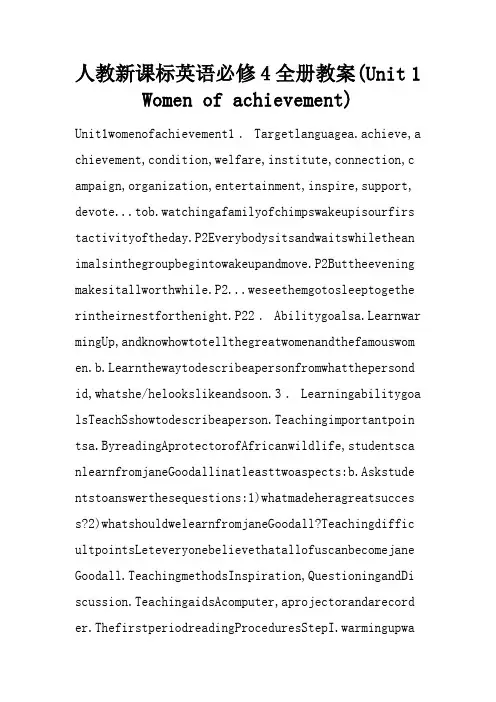
人教新课标英语必修4全册教案(Unit 1 Women of achievement)Unit1womenofachievement1.Targetlanguagea.achieve,a chievement,condition,welfare,institute,connection,c ampaign,organization,entertainment,inspire,support, devote...tob.watchingafamilyofchimpswakeupisourfirs tactivityoftheday.P2Everybodysitsandwaitswhilethean imalsinthegroupbegintowakeupandmove.P2Buttheevening makesitallworthwhile.P2...weseethemgotosleeptogethe rintheirnestforthenight.P22.Abilitygoalsa.Learnwar mingUp,andknowhowtotellthegreatwomenandthefamouswom en.b.Learnthewaytodescribeapersonfromwhatthepersond id,whatshe/helookslikeandsoon.3.Learningabilitygoa lsTeachSshowtodescribeaperson.Teachingimportantpoin tsa.ByreadingAprotectorofAfricanwildlife,studentsca nlearnfromjaneGoodallinatleasttwoaspects:b.Askstude ntstoanswerthesequestions:1)whatmadeheragreatsucces s?2)whatshouldwelearnfromjaneGoodall?Teachingdiffic ultpointsLeteveryonebelievethatallofuscanbecomejane Goodall.TeachingmethodsInspiration,QuestioningandDi scussion.TeachingaidsAcomputer,aprojectorandarecord er.ThefirstperiodreadingProceduresStepI.warmingupwarmingupbydescribingGoodmorning,class.Todaywearegoin gtoreadaboutAPRoTEcToRoFAFRIcANwILDLIFE.Butfirst,I’dliketoknowifyouhaveeverheardofwomenlikeElizabethFr y,Soongchingling,janeGoodall,jodywilliams,joanofArc andLinQiaozhi.Nowturntopage1,lookatthephotos,readth ecaptionsanddescribetoyourneighborthewomeninfocus.w hoisshe?whatisshe?whatdidshedotobenefittheworld?war mingupbydiscussingHi,everyone.Howdidyouspendyourwin tervacation?Didyoureadanybooks?Didyoureadanywomenof achievement?whatmakesawomanofachievement?Nowinpairs discussthewomenonpageone.whichofthesewomendoyouthin kisagreatwoman?Givereasonsforyourchoice.warmingupby readingaloudandtranslatingNicetoseeyoubackatschool, boysandgirls.Asyouhaveallpreparedlessonsbeforeclass Ishallasksixofyouatrandomtoreadaloudandtranslatethe captionsunderthephotosonpageone.Zhaoyanfei,wouldyou tryreadingaloudandtranslatingthefirstcaption?welldo ne!Nextlet’shavejuXiaohongdothesecondone.StepII.Pre-reading1.Lookingandsayingworkinpairs.Lookatthephotosandtheti tleAPRoTEcToRoFAFRIcANwILDLIFEandpredictthecontentsofthetext.whenyouareready,joinanotherpairandcompare yourpredictionsandthecluesthathelpedyoutomakethepre dictions.2.Talkingandsharingworkingroupsoffour.Tellyourgroupma teswhatyouknowaboutwildlifeprotection.Thenthegroupl eaderistostandupandshareyourgroupideawiththeclass.S tepIII.Reading1.ReadingaloudtotherecordingNowpleaselistenandreadalo udtotherecordingofthetextAPRoTEcToRoFAFRIcANwILDLIF E.Payattentiontothepronunciationofeachwordandthepau seswithineachsentence.Iwillplaythetapetwiceandyoush allreadaloudtwice,too.2.ReadingandunderliningNextyouaretoreadandunderlineal ltheusefulexpressionsorcollocationsinthepassage.cop ythemtoyournotebookafterclassashomework.3.ReadingtoidentifythetopicsentenceofeachparagraphSki mthetextandidentifythetopicsentenceofeachparagraph. youmayfinditeitheratthebeginning,themiddleortheendoftheparagraph.4.ReadingandtransferringinformationReadthetextagainto completethetable,whichlistwhatjanedoestoprotectAfri canwildlife.whatdoesjanedo?Studiedtheseanimalsforma nyyearsSpentmanyyearsobservingandrecordingtheirdail yactivitiesDiscoveredthatchimpshuntandeatmeatDiscov eredhowchimpscommunicatewitheachotherArguedforchimp stobeleftinthewildSetupspecialplacesworkingwithanim alsintheirownenvironment5.ReadingandunderstandingdifficultsentencesAsyouhaver eadthetexttimes,youcansurelytellwhichsentencesaredi fficulttounderstand.Nowputyourquestionsconcerningth edifficultpointstometheteacher.StepIV.closingdowncl osingdownbydoingexercisesToendthelessonyouaretodoth ecomprehendingexercisesNo.1and2.2.closingdownbyhavi ngadiscussionDoyouagreewithjane’sideas?whyorwhynot?whatdoyouthinkisthebestwaytoprot ectwildlife?closingdownbyretellingthestoryofjaneGoo dallIshallwritesomekeywordsandexpressionsontheboard .youaretoretellthestoryofjaneGoodallaccordingtothesewords.ThesecondperiodLearningaboutLanguageAimsTohe lpstudentslearnaboutsubject-verbagreement.Tohelpstu dentsdiscoverandlearntousesomeusefulwordsandexpress ions.Tohelpstudentsdiscoverandlearntousesomeusefuls tructures.ProceduresStepI.warmingupwarmingupbydisco veringusefulwordsandexpressionsTurntopage4anddoexer cisesNo.1,2,3and4first.checkyouranswersagainstyourc lassmates’.StepII.Learningaboutgrammar1.ReadingandthinkingTurntopage2andreadwithmethetextof APRoTEcToRoFAFRIcANwILDLIFE.Asyoureadon,payattentio ntotheformsofsentencepredicatesandthesubject-verbag reementshowninthesentences.2.DoingexercisesNo.1and2onpage5Turntopage5.Lookatthet wosentences:ourgroupareallgoingtovisitthechimpsinth eforest.Andourgroupincludessixboysandfivegirls.Have younoticedanydifferencebetweenthem?yes.Iftheword “group”referstodifferentmembers,useapluralverb.Iftheword “group”isconsideredasawhole,useasingularverb.Nowfillintheblankswiththeproperformofthegivenverbsinbracketsonpa ge5.AndthengoontodoExerciseNo.2onthesamepage,thatis ,fillinthecorrectverbformintheletter.StepIII.Readyu sedmaterialsforSubject-verbagreementweallknowthesem eaningsof"agree,"butwhenwetalkaboutsubject-verbagre ement,we'retalkingaboutsomethingdifferent:matchings ubjectsandverbsaccordingtonumber.Thatis,whenyouhave asingularsubject,youhavetomatchitwithasingularverbf orm:Theboyplays.whenyouhaveapluralsubject,youmustha veapluralverbform:Theboysplay.Inshort,simplesentenc es,youshouldhavenoproblemwithagreement.youcanhearth eproblem:Theboysplays.whenit'swrong,itjustsoundsfun ny.However,therearefourpotentialproblemspotsthatyou needtowatchcarefully:ReversedsentenceorderThenormal patternforEnglishsentencesissubject-verb.However,th ereareafewsituationswherethisorderisreversed:o Therearesnacksonthelaundry-roomtable.owherearethey?oonthetablearethegoodies!Seehowthesubjectcomesaftert heverbineachofthese?Ifyoucanrememberhowtolocatesubj ectsandverbs,youshouldn'tblunderintomistakeswhenwritingreversed-ordersentences."-body,""-one,"and"-thi ng"wordsThecorrecttermforthesewordsisindefinitepron ouns,butifyourememberthemas"-body,""-one,"and"-thin g"words,you'llprobablybeabletospotthemmoreeasily.yo uonlyneedtoknowonething:ifawordhasoneoftheseendings ,itisalwayssingular!youcanalsoincludeeach,either,an dneitherinthisgroup.Lookatthefollowing:1.Everyoneisgoingonapicnic.2.Eachoftheboysistakinghisownlunch.3.Ifanyonedropssomethingtoeat,I'llgrabitbeforehecanpi ckitup.youshouldn'thaveproblemswiththeseifyousimply memorizetheendingsofwordsthatarealwayssingular.NoTE :wesaidthateitherandneitherarealwayssingular;howeve r,ifyouhavetwosubjectsinaneither...ororneither...no rconstruction,gettingtheagreementrightmaygiveyoufit s.Togetitright,justlocatethesubjectclosesttotheverb andmaketheverbagreewithit:oEitherthemailmanortheconstructionworkersarecausingP eggytobarklikecrazy.oNeitherthedogsdownthestreetnortheonenextdoorpaysany parethiswiththefollowing:oEithertheconstructionworkersorthemailmaniscausingPe ggytobarklikecrazy.oNeithertheonenextdoornorthedogsdownthestreetpayanya ttention.IV.closingdownbydoingaquizToendtheperiodyo uaregoingtotakeaquizonsubject-verbagreement.Thethir dperiodUsingLanguageAimsTohelpstudentsreadthepassageAGooDE XAmPLEFoRmE.Tohelpstudentstousethelanguagebyreading ,listening,speakingandwriting.ProceduresStepI.warmi ngupReadaloudtowarmup:Let’swarmupbyreadingaloudtotherecordingofthetextAGooDEX AmPLEFoRmE.StepII.Guidedreading1.ReadingandtranslatingReadthetextAGooDEXAmPLEFoRmEan dtranslateitintochineseparagraphbyparagraph.Liwenqi n.youaretodoparagraph1,please.….2.ReadingandunderliningNextyouaretoreadandunderlineal ltheusefulexpressionsorcollocationsinthepassage.cop ythemtoyournotebookafterclassashomework.3.DoingexercisesNowyouaregoingtodoexercisesNo.1and2on page6followingthearticle.4.ListeningForlisteningturntopage7andbereadytodoexerc isesNo.1,2and3.5.ActingNextwearegoingtoputthetextAGooDEXAmPLEFoRmEoN STAGE.NowZhuQingandZhangQiang,plesase!StepIII.Guide dwriting1.writinganimagineddialogueGroups1and2aregoingtowrite animagineddialoguebetweenLinQiaozhiandyou.youmaybeginlikethis:Hello,d octor.Ineedyourhelp.…2.writingadescriptionTurntopage8andfollowthedirection towriteadescriptionofawoman’scharacter.youmayusetheinformation,structuresandexp ressionsfromtheunit.StepIV.FurtherapplyingFindingin formationGotothelibrarytoreadorgetonlinetosearchino rdertofindmoreinformationonwildlifeprotection.Taken otesofyourfindingandreporttoyourgroupmatesnextmonda ymorning.writingletterswritealettereithertojaneGood allorLinQiaozhi,tellingheraboutyourlifeandhope.Acti ngatextplayTurnthearticleAGooDEXAmPLEFoRmEintoatext play.chooseyourpartandrehearsefortheSchoolArtFestiv alnextmonth.StepV.closingdownclosingdownbyfillingaf ormmakeuseofthetextandotherstofillinform.LinQiaozhi’slifehistorytimeplaceeventclosingdownbydescribingap ersonToendthisperiod,Iamgoingtohavetwoofyoustandupt odescribetotheclassapersonwhomheadmires.wholikestos peakfirst?ThefourthperiodListeningStep1Showthepictureofthebirthofboysandgirl sinchina.ThenshowanotherpictureofthejobsofthemStep2 ListeningListentothetapeanddothetrueorfalseexercises1.Girlsoftenleaveschoolearlierforfamilyreasons.2.w henthereisverylittlemoney,theschooloftenpreventsgirlsfromtraining.3.Girlsdon’thaveachancetorunacompany.4.whenwomenhavechildren,t heyhavetostopwork.5.menhavemorechancestogettothetop oftheircareerthanwomen.6.mencandowhatevertheylike.T henaskthemtoanswerthequestionwhatthreeproblemsdowom enhavewhichdonotapplytomen?Step3ListeningtextHandou tthelisteningmaterialstothestudents,Listentothetape andaskthemtocompletethepassage,afterthreetimes,enco uragesomestudentstoreadthepassagewiththerightanswer s.Step4ListeningonP41IntroducethewarbetweenFrancean dBritain.Thenmentiontheimportantwoman:joanofArcAskt hestudentstolistentothetapeandAnswerthequestions1.w hydidjoanhavetodressupasamantobecomeasoldier?2.whyd idthechurchnotlikejoanactingasaman?3.whydidFranceno twinawaragainsttheEnglishbeforejoanbecameasoldier?4 .whydidjoanhelptheFrencharmytofightbetterevenafterh erdeath?5.Howwasshehonouredafterherdeath?Atlastshow themthelisteningmaterialandgetsomestudentstoreadit。
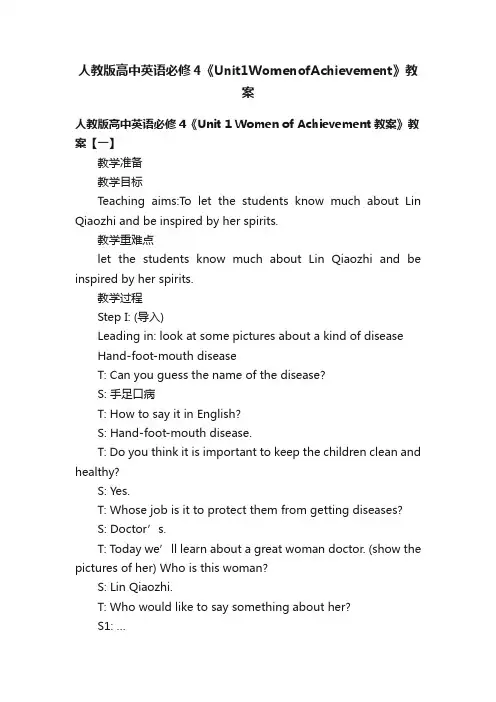
人教版高中英语必修4《Unit1WomenofAchievement》教案人教版高中英语必修4《Unit 1 Women of Achievement教案》教案【一】教学准备教学目标Teaching aims:T o let the students know much about Lin Qiaozhi and be inspired by her spirits.教学重难点let the students know much about Lin Qiaozhi and be inspired by her spirits.教学过程Step I: (导入)Leading in: look at some pictures about a kind of diseaseHand-foot-mouth diseaseT: Can you guess the name of the disease?S: 手足口病T: How to say it in English?S: Hand-foot-mouth disease.T: Do you think it is important to keep the children clean and healthy?S: Yes.T: Whose job is it to protect them from getting diseases?S: Doctor’s.T: Today we’ll learn about a great woman doctor. (show the pictures of her) Who is this woman?S: Lin Qiaozhi.T: Who would like to say something about her?S1: …S2:…T: Let’s enjoy a video about her introduction.(show the video) What do you think after watching?S:…T: Do you want to know more about her?S: Yes.【课内探究】Step II : Fast reading【自主学习】Q 1. What’s the passage mainly about?After doing some research on Lin Qiaozhi, the writer was inspired by her and decided to study at medical college and carry on her good workQ2. How did the writer know the information about Lin Qiaozhi, a specialist in women’s diseases?By chance he came across an article about her while surfing the internet.Q3. Why did Lin Qiaozhi write a small book?A. It explained how to cut the death rate from having and caring for babies.B. It gave some simple rules to follow for keeping babies clean, healthy and free from sickness.C. It was intended for women who lived in the countryside in an emergency they could not reach a doctor.D. All the above.【有效训练】Step III: Careful readingWhat are the three achievements about Lin Qiaozhi mentioned in the passage?1. She became a specialist in women diseases.2. She got a medical training for her career.3. She made sure that about 50,000 babies were safely delivered.【合作探究】Step IV: Group work1. Was it easy for a woman to get medical education at that time? Give a reason.2. What do you think are the important qualities a good doctor should have?【精讲点拨】Step V : Retell the storyLin Qiaozhi wrote a small book that ___ _______ ___ women in the countryside. It was difficult for a woman to ___ ______ ______ at that time, for girls education was always ______ ______ __ boys. _____ made her succeed was the _______ and ___________ she showed to her patients. She often went late at night to ______ __ _____for a poor family who couldn’t ____ her. I was inspired and decided to _____ __ her good work.【有效训练】Step VI: Speech timeLin Qiaozhi was a successful woman and achieved what she wanted. A Chinese saying: “Women can hold up half of the sky”. But nowadays, can women have the same chances as men in their careers? Are women and men really equal?我国男女人口出生比例示意图男女就业比例:Show your speech !What do you think? First discuss in your groups, then give your report to the class.【课后延伸】Step VII : Don’t forget your homework:1. Add more details to your speech and write it down in your exercise book.2. Surf the internet to find more about Lin Qiaozhi.课后习题I.Fast reading:Q 1. What’s the passage mainly about?Q2. How did the writer know the information about Lin Qiaozhi, a spe cialist in women’s diseases?Q3. Why did Lin Qiaozhi write a small book?A. It explained how to cut the death rate from having and caring for babies.B. It gave some simple rules to follow for keeping babies clean, healthy and free from sickness.C. It was intended for women who lived in the countryside in an emergency they could not reach a doctor.D. All the above.II.Careful readingWhat are the three achievements about Lin Qiaozhi mentioned in the passage?III. Group work1. Was it easy for a womam to get medical education at that time ?Give a reason.2. What do you think are the important qulities a good doctor should have?IV. Retell the storyLin Qiaozhi wrote a small book that ___ _______ ___ women in the countryside. It was difficult for a woman to ___ ______ ______ at that time, for girls education was always ______ ______ __ boys. _____ made her succeed was the _______ and ___________ she showed to her patients. She often went late at night to ______ __ _____for a poor family who couldn’t ____ her. I was inspired and decided to _____ __ her good work.V. Homework1. Add more details to your speech and write it down in your exercise book.2. Surf the internet to find more about Lin Qiaozhi.人教版高中英语必修4《Unit 1 Women of Achievement教案》教案【二】教学准备教学目标Te aching aims:1.Knowledge aims:In this class, most of the students will:1. learn the outline of the sample passage about a great woman.2. learn some useful expressions and structures of describinga great woman;.2.Ability aims:the students will read the sample passage and learn how to describe a great woman by imitating the sample passage.3.Emotional aims:Arouse the students’ interest of great women and le arn something from them.教学重难点Teaching important points:Students will learn to analyze the outline of a sample passage and learn to write a composition of a great woman.Teaching difficult pointsSs learn some useful expressions: be admitted to, devote oneself to.教学过程Teaching procedures:Step 1 Warming-up:Play a part of Roman Holidays and then talk about the famous actress a nd great woman Audrey Hepburn.设计意图:这是一节阅读加写作课,为避免枯燥,首先课前播放《铿锵玫瑰》歌曲,导入伟大的女性话题,然后请学生观看一段罗马假日电影片段,引入女主角奥黛丽赫本,通过图片,让学生了解到她不仅仅是一个演员还是一个伟大的女性,贴近话题。
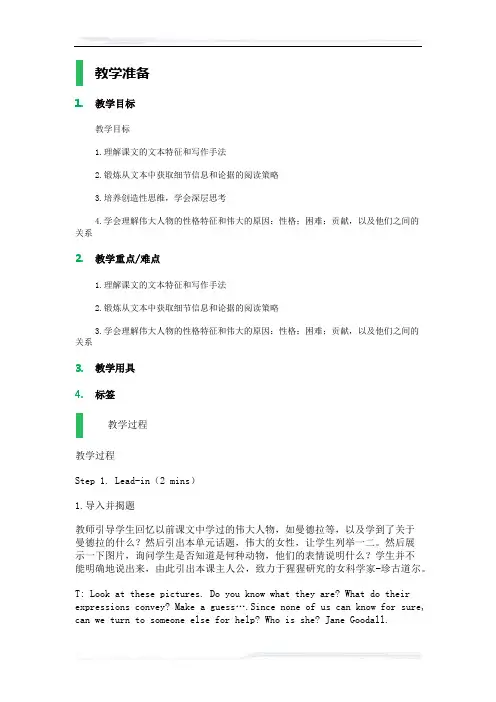
教学准备1. 教学目标教学目标1.理解课文的文本特征和写作手法2.锻炼从文本中获取细节信息和论据的阅读策略3.培养创造性思维,学会深层思考4.学会理解伟大人物的性格特征和伟大的原因:性格;困难;贡献,以及他们之间的关系2. 教学重点/难点1.理解课文的文本特征和写作手法2.锻炼从文本中获取细节信息和论据的阅读策略3.学会理解伟大人物的性格特征和伟大的原因:性格;困难;贡献,以及他们之间的关系3. 教学用具4. 标签教学过程教学过程Step 1. Lead-in(2 mins)1.导入并揭题教师引导学生回忆以前课文中学过的伟大人物,如曼德拉等,以及学到了关于曼德拉的什么?然后引出本单元话题,伟大的女性,让学生列举一二。
然后展示一下图片,询问学生是否知道是何种动物,他们的表情说明什么?学生并不能明确地说出来,由此引出本课主人公,致力于猩猩研究的女科学家-珍古道尔。
T: Look at these pictures. Do you know what they are? What do their expressions convey? Make a guess….Since none of us can know for sure, can we turn to someone else for help? Who is she? Jane Goodall.T: Do you remember what we learnt about Mandela? What made him a great person? …So, today, we will also focus on the three factors of a great woman. Characters, difficulties and achievements.[意图说明] 教师通过单元话题引起学生对已有知识的回忆,再联系到课堂,用图片导入本课的主人公,直观明了,为后面的活动奠定背景知识基础。
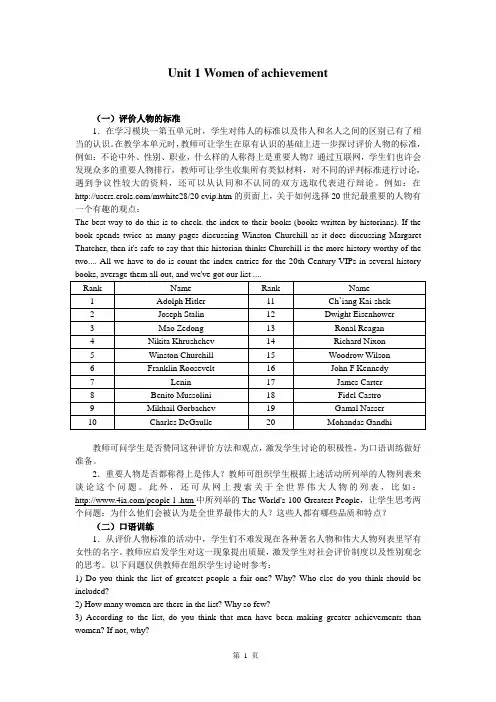
Unit 1 Women of achievement(一)评价人物的标准1.在学习模块一第五单元时,学生对伟人的标准以及伟人和名人之间的区别已有了相当的认识。
在教学本单元时,教师可让学生在原有认识的基础上进一步探讨评价人物的标准,例如:不论中外、性别、职业,什么样的人称得上是重要人物?通过互联网,学生们也许会发现众多的重要人物排行,教师可让学生收集所有类似材料,对不同的评判标准进行讨论,遇到争议性较大的资料,还可以从认同和不认同的双方选取代表进行辩论。
例如:在/mwhite28/20 cvip.htm的页面上,关于如何选择20世纪最重要的人物有一个有趣的观点:The best way to do this is to check. the index to their books (books written by historians). If the book spends twice as many pages discussing Winston Churchill as it does discussing Margaret Thatcher, then it's safe to say that this historian thinks Churchill is the more history worthy of the two.... All we have to do is count the index entries for the 20th Century VIPs in several history教师可问学生是否赞同这种评价方法和观点,激发学生讨论的积极性,为口语训练做好准备。
2.重要人物是否都称得上是伟人?教师可组织学生根据上述活动所列举的人物列表来谈论这个问题。
此外,还可从网上搜索关于全世界伟大人物的列表,比如:/people l .htm中所列举的The World's 100 Greatest People,让学生思考两个问题:为什么他们会被认为是全世界最伟大的人?这些人都有哪些品质和特点?(二)口语训练1.从评价人物标准的活动中,学生们不难发现在各种著名人物和伟大人物列表里罕有女性的名字。
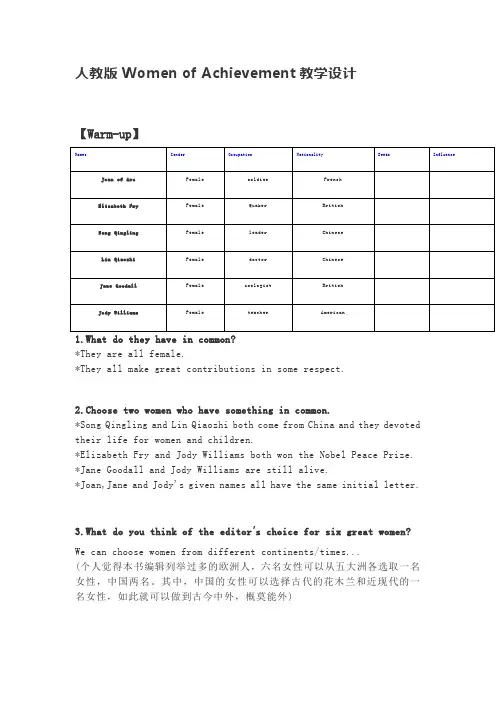
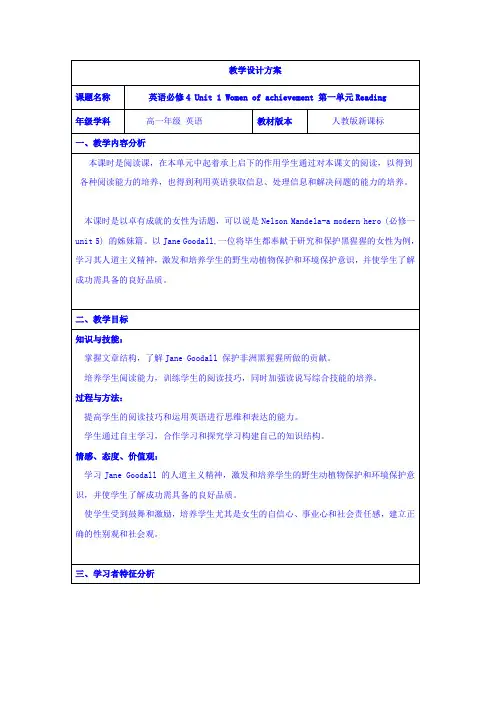
品味人生1、不管鸟的翅膀多么完美,如果不凭借空气,鸟就永远飞不到高空。
想象力是翅膀,客观实际是空气,只有两方面紧密结合,才能取得显着成绩。
2、想停下来深情地沉湎一番,怎奈行驶的船却没有铁锚;想回过头去重温旧梦,怎奈身后早已没有了归途。
因为时间的钟摆一刻也不曾停顿过,所以生命便赋予我们将在汹涌的大潮之中不停地颠簸。
3、真正痛苦的人,却在笑脸的背后,流着别人无法知道的眼泪,生活中我们笑得比谁都开心,可是当所有的人潮散去的时候,我们比谁都落寂。
4、温暖是飘飘洒洒的春雨;温暖是写在脸上的笑影;温暖是义无反顾的响应;温暖是一丝不苟的配合。
5、幸福,是一种人生的感悟,一种个人的体验。
也许,幸福是你风尘仆仆走进家门时亲切的笑脸;也许,幸福是你卧病床上百无聊赖时温馨的问候;也许,幸福是你屡遭挫折心灰意冷时劝慰的话语;也许,幸福是你历经艰辛获得成功时赞赏的掌声。
关键的是,你要有一副热爱生活的心肠,要有一个积极奋进的目标,要有一种矢志不渝的追求。
这样,你才能感受到幸福。
6、母爱是迷惘时苦口婆心的规劝;母爱是远行时一声殷切的叮咛;母爱是孤苦无助时慈祥的微笑。
7、淡淡素笺,浓浓墨韵,典雅的文字,浸染尘世情怀;悠悠岁月,袅袅茶香,别致的杯盏,盛满诗样芳华;云淡风轻,捧茗品文,灵动的音符,吟唱温馨暖语;春花秋月,红尘阡陌,放飞的思绪,漫过四季如歌。
读一段美文,品一盏香茗,听一曲琴音,拾一抹心情。
8、尘缘飞花,人去楼空,梦里花落为谁痛?顾眸流盼,几许痴缠。
把自己揉入了轮回里,忆起,在曾相逢的梦里;别离,在泪眼迷朦的花落间;心碎,在指尖的苍白中;淡落,在亘古的残梦中。
在夜莺凄凉的叹息里,让片片细腻的柔情,哽咽失语在暗夜的诗句里。
9、用不朽的“人”字支撑起来的美好风景,既有“虽体解吾犹未变兮”的执着吟哦,也有“我辈岂是蓬蒿人”的跌宕胸怀;既有“我以我血荐轩辕”的崇高追求,也有“敢教日月换新天”的豪放气魄。
33 我是一只蜜蜂,在祖国的花园里,飞来飞去,不知疲倦地为祖国酿制甘甜的蜂蜜;我是一只紫燕,在祖国的蓝天上,穿越千家万户,向祖国向人民报告春的信息;我是一滴雨点,在祖国的原野上,从天而降,滋润干渴的禾苗;我是一株青松,在祖国的边疆,傲然屹立,显示出庄严的身姿。
Unit one Women of achievement【单元教学目标】本单元主要学习为人类作出巨大贡献、取得巨大成就的女性。
学生要了解这些女性的成就以及她们因此而付出的巨大的努力。
本单元warming up部分介绍了六位伟大女性,分别是:Elizabeth Fry, Song Qingling, Jane Goodall, Judy Williams, Joan of Arc, Lin Qiaozhi。
要让学生知道这些伟大女性的生平及其巨大成就。
在阅读理解的第一篇里介绍了Jane Goodall为研究黑猩猩的生活习性而在非洲所进行的野外考察活动。
要引导学生思考:为什么她要进行野外考察?为什么要保护黑猩猩?这篇课文也是进行环境保护教育的好题材。
阅读理解的第二篇则介绍了医学科学家、妇产科专家林巧稚的成就。
【重点与难点】本单元阅读课文所接触的两位伟大女性,学生都比较陌生。
因此,要进行详细的背景的介绍。
本单元主要学习句子的主谓一致。
这也是本单元的难点。
因为汉语动词里面没有单复数的变化,因此,如何让学生掌握“数”的概念,当某些集体名词或连词出现时,如何判断使用单复数?这是一个关键问题。
Period One【教学目标】本课时主要对课文中出现的六位伟大女性及其成就进行简要介绍。
【重点与难点】课文里边出现了一些名词,如Quaker, China Welfare Institute, campaign等,估计学生不知其意,要进行适当的解释说明。
【教学过程】Step 1 单词复习、听写。
Elizabeth Fry, answer:Step 2 Pictures and QuestionsAsk Ss read the introduction of Elizabeth Fry and answer:What did she do to help the prisoners?Soong Qingling: Who is she? What’s her great achievement?Jane Goodall: What’s her achievement in the study of Chimps?Jody Williams: What did she get in 1997?Joan of Arc: Do you know the name of the girl in ancient China whose experience was similar to her?Lin Qiaozhi: What’s her major?【homework】Recite the new words【课后小结】本课时基本能完成预定的教学任务。
Unit1 Women of achievementWarming Up, Pre-reading and ReadingI.单元教学目标技能目标Skill Goals技能目标Skill GoalsTalk about important women & great womenDescribe people from their life, personality and characterWord-formation: noun suffixSubject-verb agreementMake an outlineII.目标语言功能句式Describing peopleWhat does she look like?What do you think about ...?Why do you admire her?How would you describe her?Why did she choose to ...?What are her strengths?What are her weaknesses?How do her friends describe her ?词汇1. 四会词汇achieve, achievement, condition, welfare, institute, connection, campaign, organization, specialist, behave, behavior, worthwhile, nest, observe, observation, respect, argue, entertainment, inspire, support, communication, strike, upon, article, explain, rate, medical, kindness, consideration, deliver, modest, considerate2. 认读词汇Elizabeth Fry, Quaker, Nobel Peace Prize, China Welfare Institute, Jane Goodall, chimp, JodyWilliams, landmine, Joan of Arc, Gombe National Park, specialize, career, determination, personality3. 词组devote ... to, look down upon/on, care for, deliver a baby, chosen career, be busy in doing sth, catch one’s eye, cut the death rate down, keep the baby clean and healthy, be intended for, carry on 语法Word formation: Noun SuffixSubject-verb agreement1. Our group are all going to visit the chimps in the forest.2. Our group includes six boys and five girls.3. Nobody before has fully understood chimp behavior.重点句子1. Watching a family of chimps wake up is our first activity of the day. P22. Everybody sits and waits while the animals in the group begin to wake up and move. P23. But the evening makes it all worthwhile. P24. ... we see them go to sleep together in their nest for the night. P2难句1. Only after her mother came to help her for the first few months was she allowed to begin her project. P22. For forty years Jane Goodall has been helping the rest of the world understand and respect the life of these animals. P23. ... it must have been for a woman to get a medical training so long ago when women’s education was always placed second to men’s. P64. Further reading made me realise that it was hard work and determination as well as her good nature that had got her into medical school. P65. But it was not her success at university that had made her famous.Ⅲ. 教材分析与教材重组1.教材分析本单元以女性为主题,以Warming up,Reading,listening的形式对古今中外六位不同女性的成就进行了介绍。
Unit1 Women of achievementPeriod 3Extensive Reading优秀教案The General Idea of This periodThere are three purposes in this reading Period.One is to introduce a great and famous Chinese doctor—Lin Qiaozhi and her career.She was important for women in China because she was the first woman doctor to specialize in gynaecology and obstetrics.Another purpose is to show the students a sample to describe a person.The other purpose is to direct the students how to choose their major and career.As the writer of the article is a student,and she said that it was Lin Qiaozhi’s achievement that encouraged her to study at medical college.Like the writer of the passage,the students may not have a clear idea about what they would like to do in the future.So the story might l ead to the students’ consideration about their future major and career choices andhow they may be arrived at.So it may make them take their future more seriously.Teaching Important PointsEnable the students to learn and talk about Lin Qiaozhi’s story.Enable the students to describe a person about her/his appearance,qualities and achievements.Learn some sentence patterns.Teaching Difficult PointsTo describe a person about her/his appearance,qualities and achievements.Learn some sentence patterns.Teaching MethodsSkimming to get the general idea of the story of A Good Example for me.Scanning to get detailed information and get to understand the story better.Task-based methods to get the students to comprehend the passage and be able to retell the story in their own words.Teaching AidsA tape recorderA multimediaThree Dimensional Teaching AimsKnowledge and SkillsEnable the students to learn and talk about Lin Qiaozhi’s sto ry.Enable the students to describe a person about her/his appearance,qualities and achievements.Learn some useful words and expression S:do some research,article,chosen career,explain,care for,death rate,medical training,kindness, consideration,be second to,deliver a baby.Learn some sentence patterns:It was a small book explaining how to cut the death rate from having and caring for babies byfollowing some simple rules for keeping babies clean and healthy.It struck me like lightening how difficult it must have been for a woman to get a medical training so long ago when women’s education was always placed second to men’s.It was hard work and determination as well as her good nature that had got her into medical school.It was not her success at university that had made her famous.It was her kindness and the consideration that made her famous.Process and StrategiesGroup work to carry out a heated discussion about their future career.Explanation to make the students understand Lin Qiaozhi’s spirits of dedication.Feelings and ValueThrough the reading of this passage the students are sure to learn a lot from LinQiaozhi.Meanwhile,the discussion will get the students to think a lot.Teaching ProceduresStep 1 Revision1.Greet the class as usual.2.Revise subject-verb agreement by checking the workbook exercise 1 on Page 43 and exercise 2 on Page 44.Step 2 Lead in-Brainstorm about Lin Qiaozhi.T:In this unit we focus on the great women home and abroad.Remember the one we talked aboutthe day before yesterday?Ss:Yes,of course.T:Who is she?Ss:Jane Goodall.T:Why did she impressed you so much?S:Because she devoted all her love to the chimps.S:Because she was a woman full of determination and courage.S:Because she was so unselfish that she gave up the opportunity to go to university only because of the chimps.T:Good!What you said sounds reasonable.When we are growing up we need food to give us nutrition.But the most important thing th at we couldn’t do without is the love from our parents,our friends and the ones we loves.Similarly,a person’s success couldn’t leave the love to others.Knowledge is the food that a man should absorb;while love is the sunshine,a success should show love to others.When he or she is doing so the person is really a famous person or such aperson can be a grea t person.Don’t you think so?Ss:Yes.I agree with you.T:Today we are going to talk about another famous person.Please open your textbook and turn to Page 6.Let’s have a look at this picture.Who is in it?Ss:Lin Qiaozhi.T:Wow,you can recognize her at first sight!You are wonderful.Who can say something abouther?S:Let me have a try.Lin Qiaozhi is our pride because she was Chinese.She was born in Xiamen in Fujian Province.S:I know something about her too.She was strong-willed.Lin Qiaozhi’s mother died when she was five but she was quite lucky because her father who worked at a university of Singapore believedin the education of women.That is why she as a woman in Old China got so much education.S:She once studied in the Peking Union Medical College,London University MedicalSchool,Manchester University Medical School and the Chicago University Medical School.S:She studied diseases of women,especially women in the countryside.S:Last year I went to Beijing.In the Great Hall of the People,I saw a copper statue which wasplaced to honor her and her work.T:Good job.I can see that you took the homework serious and surf the Internet to surf for a lot of information.Step 3 Getting the general ideaGet the students to read the passage and get the answers to the following questions.T:Now let’s read an article about Lin Qiaozhi.Please read the passage and get the answers to thefollowing questions.You have four minutes to go.1.What was the writer’s problem?2.What did he decide to do at last?Why?3.Which words can we find in the text used to describe Lin Qiaozhi?4.What are Lin Qiaozhi’s achievements mentioned in the passage?T:Time is up.Have you got the answers?Ss:Yes.T:Now who can answer the first question?S:1.The writer did not know which subject to choose to study at university among English,biologyand chemistry.T:Right.What about the second one?S:2.He decided to study medicine.Because he was moved by Lin Qiaozhi.T:Is he right?Ss:Yes.T:Good.The next one?S:3.There are many words such as busy,hard work,determination,good nature,kindness andconsideration that can be used to describe Lin Qiaozhi.T:It’s very careful of you to have been able t o find out so many words.In these words some are about her character and some are about her personality.Character is how she behaved in her workor towards others;while personality is to describe what she is like.Do you understand?Ss:Yes.T:What about the last one?S:4.She wrote some books and articles about women’s diseases.S:She got a medical training for her career.S:She became a specialist in women’s diseases.S:She had made sure that about 50 000 babies were safely delivered to their mothers.T:If we combine all your answers,they will make a perfect answer.Step 4 Scanning and language focusT:We have got the general understanding of the passage now.Next I would like you to listen to the tape and read the passage again.After you finish reading,you should have got the answers to these questions:1.1.When the writer was surfing the Internet,what drew her attention?2.Was it difficult for Lin Qiaozhi to get a medical training?3.What had got her into medical school?4.What made Lin Qiaozhi famous?5.What were most of Lin Qiaozhi’s stories about?T:Time is up.Who can answer the first question?S:1.When the writer was surfing the Internet,a small book explaining how to cut the death rate from having and caring for babies by following some simple rules for keeping babies clean andhealthy.T:How did you know that it drew his attention?S:He said the book caught his eye.T:So here “something catch one’s eye” means...?Ss:It means “draw one’s attention某物吸引某人的注意,某人看到了某物”.T:Good.(writes “ sth.catch one’ eye= sth.catch one’s attention/sb.see sth.” on the blackboard) What about a book explaining how to cut the death rate from having and caring for babies byfollowing some simple rules for keeping babies clean and healthy?What does it mean?S:In Chinese,it means 一本介绍如何在妇女怀孕到护理婴儿的过程中通过一些使婴儿保持清洁健康的简单规则来降低死亡率的书。
Unit1 Women of achievement单元教案This unit stays focused on the topic:women. Six women with various national backgrounds are featured, and different aspects of their life are explored, like, their social position, contributions and hardships ;meanwhile, their achievements in a wide variety of fields are highly praised. Ss will know better the roles women play in social life, with their(esp. girl students’)self-esteem and sense of social responsibility boosted.1.Warming-up requires Ss to comment on the 6 women and give their opinions and reasons aswell. This part connects Unit5,Module1.The rules concluded in the earlier unit can be applied here to identify great women. Ss should be encouraged to discuss what these women did for other people, and what problems they had to overcome or what they had to give up to achieve their ambition.2.Pre-reading is also a discussion but focused on Jane Goodall. The two questions raised hereprompt Ss to think over the pros and cons of two approaches to scientific study(lab research & field research). Then, Ss are asked to predict the content based on the title and pictures.3.Reading-A Student of African Wildlife depicts a scene where Jane and her colleaguesstudied chimps in an African forest and explains the significance of their work and the achievements she reached. Despite the fact that it was a dirty and tiring job to do the field research in the wild, they all regarded it as worthwhile. Some of their valuable discoveries would not have been made in the lab;for the very reason Jane Goodall had chosen the primitive African forest to study in.Her years of observing and recording chimps’daily activities attributed to a better understanding of their behaviour. She has argued that wild animals be left in the wild and not used for entertainment or advertisements. She has endeavored to enhance people’s awareness of understanding, respecting and protecting wild animals. She is an inspiring role model !prehending consists of 4 Exx, guiding Ss to comprehend the reading passage at differentlevels. Exx1-3 are intended to aid Ss to obtain important details ,grasp paragraph main ideas and transfer text information in the form of multiple choice, summing-up and filling in a chart.The 4 open-ended Qs in Ex4 encourage Ss to think in oth ers’ shoes, which helps strengthen Ss’ faith in animals protection.5.Learning about Language is to discover and practice useful words, expressions and structures.Discovering useful words and expressions is meant to help Ss to further study word formation, key words & phrases; Discovering useful structures centers on “subject-verb agreement”, determining the number of collective noun being the priority for the moment.Form-Meaning-Use approach is encouraged in grammar study.ing language is to train Ss’ integrating skills in listening, speaking , reading and writing.Reading features Lin Qiaozhi,a famed specialist in women disease, who achieved great success in her career with remarkable perseverance and efforts. She cared about women and mothers, esp. those living in poverty, and earned respect with her kindness and warn heart.Plus, she dedicated all her life to her patients and Chinese medical care. Ss are expected to learn about an outstanding woman’s life, and, more importantly, get enlightened when considering their future career choice. (Listening, Speaking & writing:omitted)7.Summing Up,Learning Tip,Reading for Fun:omitted8.Key points covered in this unit are summarized as follows;⑴ know about great women of achievement in various fields and discuss their qualities;(2) learn how to describe a person with adjectives about people’s qualities and personalities;(3) well identify the number of collective noun and master the corresponding principle ofkeeping verb-form in agreement with the subject;(4) master how to change nouns into verbs, vice versa; Further study word formation;(5) master the following words, expressions and their usage in concrete context:(pls refer to TB4 p.1)____________________________________________________________________________ Period One Warming up (p.1); Using language:Listening (p.7)☆ Teaching objectives1. ability●Ss will be able to learn about and briefly talk about the 6 women’s life, main deeds andcontributions in Warming up;●Ss will be able to develop the abilities of pre-listening predicting &listening for keywords while listening .2. language knowledge & skillsAfter this period of learning Ss will be able to:●Understand the meaning of the following words & phrases and master their basic usage:achievement, welfare project, institute, specialist, connection, human beings, campaign,organization, dress as, help do sth, concern oneself with sth, devote on e’s life to sth,found a campaign to do sth●Learn how to use the following key sentence patterns:Joan of Arc was a girl from the countryside who dressed as a man and went to fight forthe French.She helped drive the English out of France.She helped improve prison conditions and gave prisoners work and education.She concerned herself with welfare projects, especially the China Welfare Institute forwomen and children.She devoted all her life to medical work for Chinese women and children.Her research showed the connections between chimps and human beings.Jody Williams helped found an international campaign to stop the making of landmines.3. cultural consciousnessSs will be able to know about the unfairness women meet with in society and take a right attitude towards gender difference☆ Teaching procedures & waysⅠ:Warming up1. What did Joan of Arc ,Elizabeth Fry, Song Qingling, Lin Qiaozhi, Jane Goodall and Jody Williams do respectively?dress as / fight for / drive sb out of …\\help improve …\\concern oneself with …\\devote one’s life to …\\show the connections between …\\found a campaign to …Ⅱ:Discussion1. What do these six women have in common?devoted, determined, committed, inspiring, influential, had careers2. Do you still remember Nelson Mandela? What do you think makes a great man or womanⅢ:Listening1. Discuss in groups.◆Is it easy for women to succeed?◆What difficulties might women meet? Do you think men have the same problems?Give reasons.2.Listen for the first time and check the ideas that you have just discussed before3. Listen to the tape again and take notes on the three problems given in the listening.-Ex24. Listen once more and fill in the blanks-Ex3Ⅳ:DiscussionIt is said that “it is more difficult for a woman to be successful”. Do you agree or disagree?State your reasons.Ⅴ:Summary and homework1. Remember the following words and expressions.✓achievement, welfare project, institute, specialist, connection,human beings, campaign, organization, found a campaigndress as / fight for / help drive sb out of some place /help improve / concern oneself with / devote one’s life to /show the connections between …2. Preview the reading “A student of African wildlife”.Study the new words and finish Eexercise 1 on page4☆ Reflection:_______________________________________________________________________________ _______________________________________________________________________________ _______________________________________________________________________________ _______________________________________________________________________________ _______________________________________________________________________________ _______________________________________________________________________________ _______________________________________________________________________________ Period Two Pre-reading (p.1); Reading; Comprehending (pp.2-3)☆ Teaching objectives:1.ability●Further train Ss to predict the content based on the title and pictures;develop Ss’ readingskills of grasping the gist, summing up Para. main ideas, obtaining key information, raising Qs (general,detailed,inferring,writing skills) ,and retelling the text with some questions and words as a support;●Develop Ss’ ability to acquire information through reading; summarize the methods ofobserving chimps and Jane Goodall’s achievements in chimp study and protection.2. language knowledge & skillsAfter this period of learning,Ss will be able to master the following language items in the specific context of the passage-“A Student Of African Wildlife” After this period of learning,Ss will be able to use●Key words & phrases:behave, behaviour, shade, worthwhile, nest, bond, observe, childhood, respect, argue,entertainment, inspiremove off, be outspoken about, lead a busy life, crowd in●Key structures:Watching a family of chimps wake up is our first activity of the day.Everybody sits and waits in the shade of the trees while the family begins to wake upand move off.Jane warns us that our group is going to be very tired and dirty by the afternoon and sheis right.Her work changed the way people think about chimps.3. Affect & attitudeGuide Ss to appreciate the heroine’s spirit of braving hardships.☆ Teaching procedures & ways:I. Pre-reading1. Retell the story about Jane Goodall.study chimps in Africa, show the connections between chimps & human beings, protect chimps 2. Discuss in groups.•Why do you think Jane Goodall went to Africa to study chimps rather than to university?•Do you think she was right? Give your reasons.•Can you think of the possible difficulties that Jane Goodall might meet doing her research without training?3. PredictionLook at the title and the pictures. Then answer the following questions.1) What do you think the passage will tell us?2) What is Jane Goodall doing in the picture on the top right?3) What is Jane Goodall doing in the picture on the bottom left?4. V ocabulary matching.•_____ close connection that people have with each other•_____ to fill sb with feelings or aims•_____ (of thoughts, questions, etc) to fill one’s mind•_____ the period of time when someone is a child•_____ giving opinions openly and honestly• _____to move away from a place; to leave • _____ task that requires a lot of time and effort• _____ to watch carefullyII. Reading1. Fast reading Skim the passage and underline the basic information : what , who , why , where , when , how .2. Underline the topic sentence in each paragraph. Following Jane’s way of studying chimps, our group are all going to visit them in theforest.Nobody before Jane fully understood chimp behaviour.For forty years Jane Goodall has been outspoken about making the rest of the world understand and respect the life of these animals. She has achieved everything she wanted to do. 3. Ssummarize the main idea of each paragraph-Ex2 p.34. Discover the structure of the text.Description of a woman scientistExplain her research method Describe her work and achievements Through the eyes of a visitor Her discov eries Her achiev ements Her conti nuing work5. Ask questions.Make up questions within your group based on the reading. Each group chooses a best questionand the other groups compete to answer it.E.g. what’s the main idea of the first paragraph? (General)When did Jane first arrive in Gombe? (detailed)What do we know about Jane’s personality from the second paragraph? (make an inference)Which part is the summary of the reading? (writing skills)…6. Answer more questions from the T.➢ In which way has Jane helped people? (behave)➢ What did we do before we followed the chimps wandering into the forest? (shade, moveoff)➢ What did the writer think of the evening? (worthwhile)➢ What did the writer realize after a day ’s watching? (bond)➢ How did Jane discover the society of chimps? (observe )➢ How did Jane try to protect the lives of chimps in their natural habitat? (be outspokenabout, respect, argue)➢ When did Jane want to work with animals in their own environment? (childhood)➢ What about Jane’s life now? (lead a busy/meaningful life)Activity III. Post-reading1. In your group rretell the text using the following questions and words as a support.➢ What did the writer do? (behave, shade, worthwhile, bond)➢ What did Jane Goodall do and find out about chimps? (observe, discover)➢ What did Jane Goodall do to protect the chimps? (be outspoken about, respect, argue)➢ What about her achievements?2. Discuss in groups.➢ Reconsider the title. Do you understand it differently? Discuss with your partners.➢ Do you think it is more important to study chimps in the wild rather than in a zoo? Givereasons.➢ Do you think you would go if you are asked to study animals in the wild? Why or whynot?IV . Summary and homework1. Remember the following words and expressions.behave, shade, move off, worthwhile, nest, bond, behaviour, observe, childhood, be outspokenabout, respect, argue, entertainment, lead a busy life, crowd in, inspire2. Finish Exercises 1 and 3 ( p. 3) and Exercise 3 (p. 4).☆ Reflection :__________________________________________________________________________________________________________________________________________________________________________________________________________________________________________________________________________________________________________________________________________________________________________________________________________________________________________________________________________________________ _______________________________________________________________________________ Period Three Using language:Reading (p.6), Speaking (p.7)☆ Teaching objectives1. abilityAfter this period of learning,Ss will be able to●obtain important information by means of reading and sum up the heroine’s qualities;●describe a person’s quality and personality.2.language knowledge & skillsAfter this period of learning,Ss will be able to use the following language items:●key words & phrasessickness, intend, emergency, generation, kindness, consideration, deliverdo research on, by chance, come across, cut the death rate, carry on●key sentence patternsBy chance I came across an article about a doctor called Lin Qiaozhi, a specialist in women’s diseases.Who were the women that Lin Qiaozhi thought needed this advice?Further reading made me realize that it was hard work and determination as well as her gentle nature that got her into medical school.☆Teaching procedures & waysI. Review1. Review Jane Goodall’s story. Use as many new words from the passage as possible.•behave, behaviour, shade, worthwhile, nest, bond, observe, childhood, respect, argue, entertainment, inspire•move off, be outspoken about, lead a busy life, crowd in2. Check the homework. Share your mother or grandmother’s experiences with your group.Now Let’s look at the career of somebody who lived at the same time as your grandmother. II. Pre-reading1.What do you know about Lin Qiaozhi? (a doctor, a specialist in women’s diseases …)2.Which adjectives could you use to describe her?(devoting, kind, inspiring, respected,clever, …)III. Reading1. Read for the first time. List three of Lin Qiaozhi’s achievements.—Ex 1 p.62. Find the words or phrases in the text to replace the underlined parts.I went to all the bookstores of the town to buy the book, but failed. Today, I found it bychance in my friend’s house. (came across)Last night the heavy rain destroyed the country road and the only doctor in the village had to help a woman to give birth to a baby. (deliver a baby)After my partner left I tried to continue our work as usual. (carry on)The book is designed for children. (is intended for)3. Read again and answer the following questions by using sentences from the passage.➢When did the writer decide to study at a medical college? (do research on)➢How did the writer find the article about Lin Qiaozhi? (by chance, come across)➢For whom and for what purpose did Lin Qiaozhi write a small book about how to look after babies? (cut the death rate, be intended for)➢Why was it difficult for Lin Qiaozhi to get medical training? (generation, be placed second to)➢What helped Lin Qiaozhi succeed later on? (kindness and consideration)➢Why do you think the writer chose to study at medical college? (carry on )IV. Post-reading1.Work in groups to discuss what are the important qualities a good doctor should have.Ex2Q4 p.62. What do you think of Lin Qiaozhi? Work in groups to think out the adjectives which candescribe one’s quality.hard-working energetic active determined intelligent fair generous kind helpful confident brave honest unselfish devoted educated warm-hearted modest considerate strong-minded self-reliant self-respected responsible3. Group work. Use the adjectives to talk about the great person you admire. Follow the given outline.Outline:1) Topic sentence2) Supporting sentences3) ExamplesV. Summary and homework1. Remember the following words and expressions.do research on, by chance, come across, cut the death rate, intend, emergency, generation, kindness, consideration, deliver, carry on2. Write a composition about the person you admire based on your classroom talk.☆Reflection:_______________________________________________________________________________ _______________________________________________________________________________ _______________________________________________________________________________ _______________________________________________________________________________ _______________________________________________________________________________ _______________________________________________________________________________ _________Period Four Learning about language:Discovering useful words and expressions (p.4);Using words and expressions (p.42)☆ Teaching objectives:☆Teaching procedures & waysI. Homework checkingShare your writing with our group. Check with each other.II. Word formation1.Fill in the chart with a suitable verb or noun form. Pay attention to the connectionbetween them. (p.4 Ex. 2)••appreciate--- examine---•admit--- educate---•tour--- type---✓✓act--- conduct--- sail---✓attend---✓admit--- attend--- guide---✓employ--- train---✓depart --- press--- fail---III. VocabularyWork in groups and study the words and expressions. Try to summarize the usages. Then make sentences by yourselves.1. achieve sth (success, goal, aim, purpose, etc)1) He achieved his ambition of making a robot.2) Because he was hard-working, he achieved fullmarks in the exam.n. achievement1) The achievement as a teacher is to show his students how to learn.2) A sense of achievement will encourage students to make more efforts.2.campaign3.dress4. put… to death5.deliver6.behave7.argue8.worthwhile9.observe10.lead a… life11.crowd in12.look down upon13.intend14.carry onIV. Practiseplete the sentences with the words in their proper forms.1) A sense of_______ (achieve) is very important for a student.2) It is strange that the old lady is_______ (dress) in red.3) His life _________ (devote) to helping the poor.4) It is worthwhile_______(walk) to work every day.5) The school being built is_________(intend) for the homeless children.2. Complete the passage-Ex2 p42V. Summary and homework1. Summarize noun suffixes.2. Finish Exercises 1 and 3 on page 42.☆ Reflection:_______________________________________________________________________________ _______________________________________________________________________________ _______________________________________________________________________________ _______________________________________________________________________________ _______________________________________________________________________________ ___________________Period Five Learning about language:Discovering useful structures (p.5);Using structures (p.43)☆ Teaching objectives1. Master the principles of subject-verb agreement when collective nouns,pronuns,nouns or/and pronuns connected by connectors;2. apply the language knowledge about subject-verb agreement to practice.☆Teaching procedures & waysI. Review-the definition of subject-verb agreementChoose the correct verb form. Can you summarize the rules?•I am/are seventeen. // She is/are sixteen.•There is/are a desk in the room.·There is/are no chairs in it.•John gets/get up at six o’clock every morning.•They has/have not come yet.•What is/are the latest news about the Olympics?II. Collective nouns1.Study the examples in Ex1 p.5 and2. More examples inEx2 p.5III. PronounsIV. Other examplesV. Summary of subject-verb agreement rules:Read through the Grammar summary on pages 88-89.VI. HomeworkFinish Exercise 2 on page 5 and Exercises 1 and 3 on page 43☆Reflection_______________________________________________________________________________ _______________________________________________________________________________ _______________________________________________________________________________ _______________________________________________________________________________ _______________________________________________________________________________ _______________________________________________________________________________ _________Period Six Listening and talking (p.41); Listening task (p.44); Reading task (p.44)☆ Teaching objectivesAfter this period of learning, Ss will be able to:1. predict the listening content based on the picture and already-known information ; take notes of key points while listening;2. ⑴adeptly describe a person with adjectives & describe differences between persons;(2)maintain a talk by resorting to communicative strategies, like, asking & clarifying Qs3. while reading,grasp key information & take special note of connecting words.☆Teaching procedures & waysI. Listening1. Look at the picture on page 41 and read through Exx 2 & 3. What can you predict about the listening?2. listen to Part 1 and finish Ex2 p.413. Listen to Part 2 and finish Ex 3. p.41II. Talking1.Which Chinese woman in the past also disguised herself as a man to join the army?2. Compare Joan of Arc and Mulan3. Read the questions in pairs. You can make up more questions.1)Why do you admire her?2)What did she do to impress you most?3)How would you describe her?4)Why did she choose to join the army?5)Was she successful? What happened to her later?6)Can you give an example to show …?4. Make up a short dialogue in pairsS1:Do you think that Joan of Arc was like Mulan?S2:Well, I suppose she was in some ways. They were both brave, weren’t they?S1:Yes, but I admire Mulan more.S2:What did she do to impress you?S1:…III. Listening Task p441. Before Listening. T:We are going to listen to a dialogue between Ding Lingyu and Ms JodyWilliams about the latter’s work to ban landmines.1)What does ICBL mean?2)Why are landmines dangerous? What can landmines do to people?2. Listen to Part 1 carefully and take notes. Fill in the chart in Ex2 p443. Listen to Part 2 and fill in the blanks. Ex3 p44IV. Reading Task p441. What do you know about Elizabeth Fry from Warming-up?A Quaker // Helped improve prison conditions and gave prisoners work and education //Helped the Quakers get the Nobel Peace Prize in 19472. Skim the reading about Elizabeth in five minutes and finish Ex 1. p44V. Homework1. Remember all the new words and phrases in Unit 1.2. Finish Exercise 2 on page 45.3. Think about a special woman you admire and look for some information about her.☆Reflection:_______________________________________________________________________________ _______________________________________________________________________________ _______________________________________________________________________________ _______________________________________________________________________________ _______________________________________________________________________________ _______________________________________________________________________________ _________Period Seven Using language:Writing (p.7), Summing up (p.7)☆ Teaching objectivesAfter this period of learning, Ss will be able to:1. write about a person’s life and work , using basic writing skills&strategies properly2.sum up what has been covered in Unit 1☆Teaching procedures & ways.I. Lead in1.Review the three passages we have read.Think about:➢what we can write when introducing a person;➢how we shall organize an article about a person.2. Talk about a great woman you admire.II. Summary1. Possible content:1)personal information2)personality and quality3)things she/he has done4)evaluation from other people2. Possible ways to write the article:Part 1:an introduction of the personPart 2:supporting details1) characters2) achievementsPart 3:a conclusion1) what you think of him/her2) how people view him or her3. Description and evaluation vocabulary4. Writing Tipthat shows theperson’s character.(p. 8)5. Sayings & proverbs :Reading for fun (p.8)•You have to believe in yourself. That’s the secret of success. (Charles Chaplin) 人必须相信自己,这就是成功的秘诀。
Book4,Unit1,Women of Achievement The Second Period GrammarTeaching goals 教学目标1. Target language 目标语言a. 重点词语achievement,inspire,worthwhile,observe,institute,respect,condition,argue, entertainmentb. 重点句子2. Ability goals 能力目标a. Enlarge vocabulary by learning word-formation.b. Learn to use Subject-verb agreement correctly.3. Learning ability goals 学能目标Teach Ss how to enlarge vocabulary by word-formation and how to use subject-verb agreement.Teaching important points 教学重点a. Noun Suffix in word-formation.b. Subject-verb agreement of collective nouns.Teaching difficult points 教学难点Enable students to use collective nouns correctly, by understanding their meanings in certain situations.Teaching methods 教学方法Let students do the exercises, and then collect their answers. Ask them to conclude the rules and then give them some explanation.Teaching aids 教具准备A projector.Teaching procedures & ways 教学过程与方式语法详解:所谓主谓一致是指主语和谓语动词之间,即主语的人称和单复数形式决定着谓语动词对应的形式。
人教版高中必修四英语Unit 1 Women of achievement 教案【教学内容】人教版新课标高中英语必修4 第一单元(Unit 1 Women of achievement) 第一课时阅读课 A SUDENT OF AFRICAN WILDLIFE【教材分析】本单元紧扣“女性”这一中心话题,通过介绍几位生活在不同国度的杰出女性,探讨女性在社会生活中的地位、价值和贡献,关注她们所面临的困难,讴歌她们在社会各个领域的成就。
学习本单元内容有助于提高学生对妇女的社会角色的认识,培养学生(尤其是女学生)的自信心、事业心和社会责任感,建立正确的性别观和社会观。
“热身”(Warming Up)部分要求学生评论课本列出的六位女性,就她们是否称得上是“伟人”提出自己的观点和理由。
该部分呼应了模块一中第五单元Nelson Mandela-a modern hero的“热身”部分。
在学习这一单元时,学生们经过讨论已总结出区分名人与伟人的标准。
因此,在教学本单元时,教师可以让学生沿用这一标准,并针对本单元具体内容进行讨论,当然,学生也可以提出自己的看法。
教师应当鼓励学生提出异议,但必须注意以下两点:(1)学生所提出的观点要有积极意义;(2)学生应有理有据地阐述自己的观点并使其令人信服。
“读前”(Pre-reading)部分提出了两个问题:Jane Goodall 为什么不在大学里进行专业的生物学研究而要到非洲去研究黑猩猩?她的工作有什么重要意义?这两个问题不仅要求学生思考她的工作对人类的影响,还要求学生思考两种不同的研究方法(即实验室研究法与野外研究法)的优势与不足之处。
“阅读”(Reading)部分以《非洲野生动物保护者》为题,描写了Jane与她的同事们在非洲原始森林观察非洲黑猩猩的一个片段,并阐释她从事这项工作的重要性以及她所取得的成就。
尽管他们在野外的考察工作又脏又累,但他们觉得这样做是值得的,他们有一些重要的发现是在学校的实验室不可能获得的,这正是Jane Goodall要到非洲原始森林来的原因。